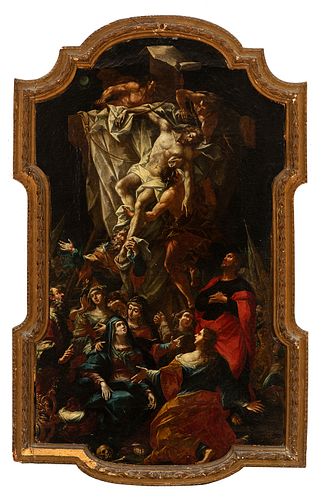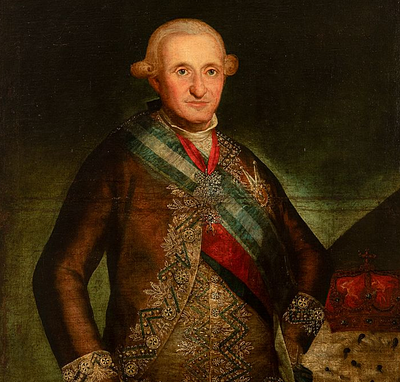Italian school; second half of the 18th century. "Descent from the Cross". Oil on canvas.
Lot 25
About Seller
Setdart Auction House
Carrer Aragó 346
Barcelona
Spain
Setdart Subastas was born in 2004 and is currently the first online art auction in Spain with solidity, prestige and reliability guaranteed by our more than 60,000 users. Setdart has a young, dynamic and enterprising team ready to successfully manage the purchase and sale of art works through custom...Read more
Estimate:
EUR€2,500 - EUR€3,000
$2,604.17 - $3,125
Absentee vs Live bid
Two ways to bid:
- Leave a max absentee bid and the platform will bid on your behalf up to your maximum bid during the live auction.
- Bid live during the auction and your bids will be submitted real-time to the auctioneer.
Bid Increments
| Price | Bid Increment |
|---|---|
| EUR€0 | EUR€10 |
| EUR€200 | EUR€25 |
| EUR€500 | EUR€50 |
| EUR€1,000 | EUR€100 |
| EUR€3,000 | EUR€200 |
| EUR€5,000 | EUR€500 |
| EUR€10,000 | EUR€1,000 |
| EUR€20,000 | EUR€2,000 |
| EUR€50,000 | EUR€5,000 |
About Auction
By Setdart Auction House
Sep 22, 2021
Set Reminder
2021-09-22 09:30:00
2021-09-22 09:30:00
America/New_York
Bidsquare
Bidsquare : 22nd September - ARAS JÁUREGUI Private Collection - Old Masters, 19th & 20th Century
https://www.bidsquare.com/auctions/setdart-auction-house/22nd-september---aras-j-uregui-private-collection---old-masters-19th-20th-century-7427
ARAS JÁUREGUI Private Collection - Old Masters, 19th & 20th Century Setdart Auction House sofia@setdart.com
ARAS JÁUREGUI Private Collection - Old Masters, 19th & 20th Century Setdart Auction House sofia@setdart.com
- Lot Description
Italian school; second half of the 18th century. "Descent from the Cross". Oil on canvas. The original canvas is preserved. It has a period frame of carved and gilded wood. In addition to partially illegible inscriptions on the back. It has repainting, holy xylophagous remains in the wood and back reinforcement in the frame. Measurements: 102 x 60 cm; 111.5 x 69.5 cm (frame). In this monumental work of mixtilinear format we find a scene of devotional character, which stands out for its great aesthetic and thematic expressiveness. We find ourselves before a Descent from the Cross, which is made up of a number of characters, which express a certain degree of expressive emotional restraint. The composition is dynamic, distributing the characters into two distinct groups. The work is divided into two spaces, the upper and lower, which would represent a divine and an earthly space. However, both spaces are joined together in a helicoidal movement brimming with narrative, with the presence of Christ's body as the main protagonist. Next to the recumbent body of Jesus, several figures are arranged to assist Christ's descent, two of whom are located in the upper part of the cross, while one of them is on the right side, carrying the recumbent body on his arms. The aforementioned figures are notable for their musculature, which suggests the effort involved in this task. In the lower part, a fourth figure takes part in this descent, holding one of Jesus' feet, probably Nicodemus, which can be deduced from his advanced age and his beard, although he does not wear the characteristic turban. His predominant presence in the composition is due to the fact that, according to the Gospel of Mark, he was the only one who dared to go to Pilate to ask him for the body of Christ. Another prominent figure in the lower part of the scene is located on the right, standing in a green tunic and red cloak, looking towards the body of Christ and placing his hands on his chest in an attitude of piety. The colour of his clothing suggests that this is the figure of Saint John the Evangelist, a key figure in Byzantine Deesis, in which the body of Christ on the cross is depicted. Returning to the central group, this one features the figure of the Virgin Mary and Mary Magdalene, both arranged in opposition to each other, thus creating a reciprocal tension that defines the drama of the scene. The Virgin faces the viewer, and Mary turns her back, both with a gesture of deep sorrow, raising her gaze towards the deceased. The warm, smooth tones of the red and emerald robes model the anatomies, characterised by their monumental bearing, just as sculptural are the figures that make up the rest of the scene, whose disorderly presence lends great dynamism in harmony with the theme of the scene. Also worthy of note is the lighting, which is very carefully studied and also typical of this school. It is a contrasting, dramatic light that models the faces and anatomy of Christ in an attempt to achieve a realistic, almost illusionistic appearance. This lighting is close to the more natural Italian school, which seeks excessive contrasts. On the other hand, it should be noted that these same contrasts can be seen in the harder, geometric folds.
- Shipping Info
-
In-house shipping available. Please inquire at admin@setdart.com.
-
- Buyer's Premium



 EUR
EUR CAD
CAD AUD
AUD GBP
GBP MXN
MXN HKD
HKD CNY
CNY MYR
MYR SEK
SEK SGD
SGD CHF
CHF THB
THB

















